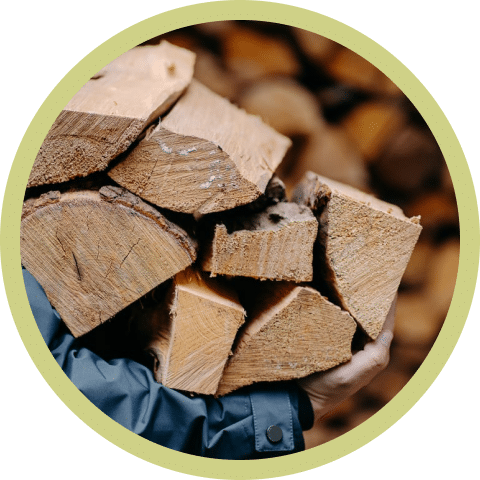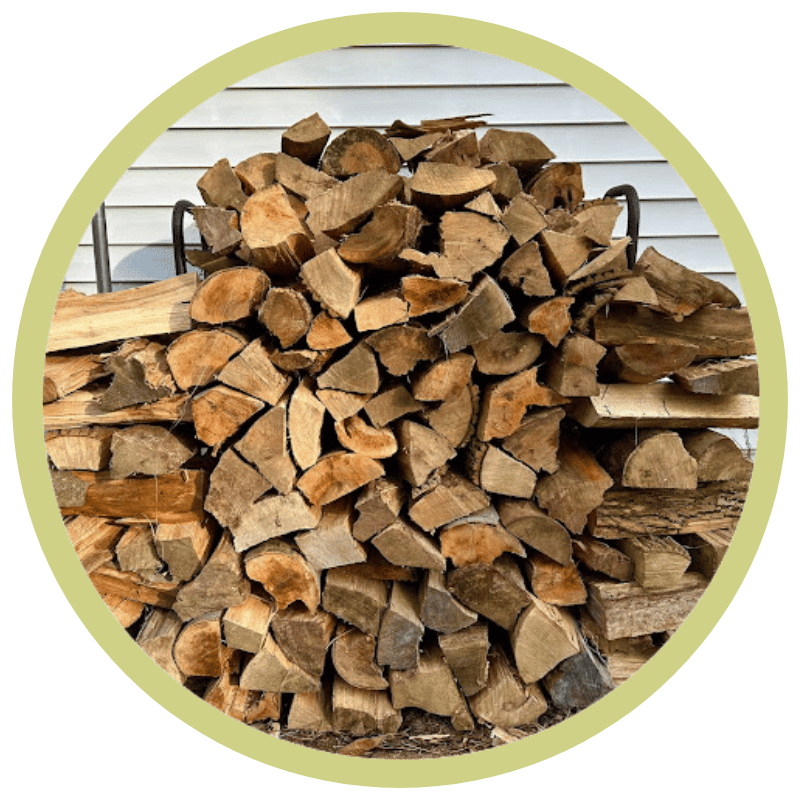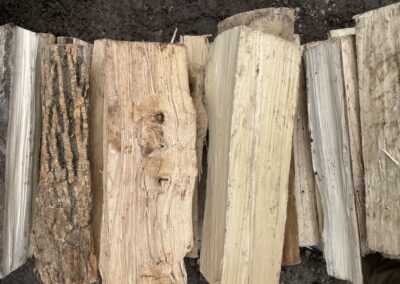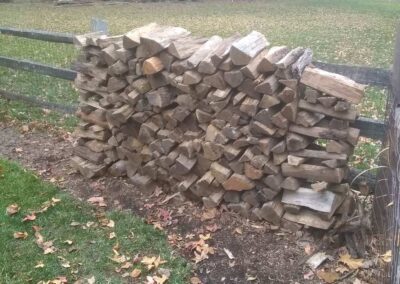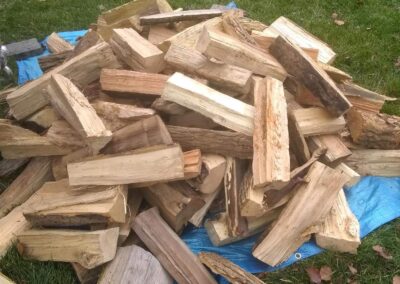Cord of Wood
Each Order Supports a Local Cause
Online Ordering | Delivery or Stacking

What We Do
Schedule your firewood delivery with a few easy clicks. We will send reminders via text and email as your delivery date approaches.
Our firewood is mixed hardwood including oak, ash, cherry, and hickory. Order kiln-dried or air-dried firewood by the rick and choose delivery only, or we can even stack the firewood for you!
By ordering firewood with Haulstr, you are supporting our Wood for Good program. A portion of each firewood order is donated to a local cause. You can select an inspiring cause during checkout.
Firewood Delivery
Let Haulstr bring your Firewood to you. Schedule today and get your order delivered.
Firewood Delivery
Let Haulstr bring your firewood to you. Schedule today and get your order delivered.
Firewood Stacking
Let Haulstr do the heavy lifting. We can stack your firewood and have you ready to enjoy your next fire.
Firewood Stacking
Let Haulstr do the heavy lifting. We can stack your firewood and have you ready to enjoy your next fire.
How to Order

Enter Your Zip Code
To confirm available services in your area

Select Your Service
Firewood or Mulch delivery, Patios, Landscaping, Dumpster rentals, and more.

Schedule and Pay
Easily schedule your service online. We accept multiple payment methods to quickly checkout.
“Very dependable. Great service on fire wood. Will definitely use this company for my landscaping this summer. Great company!!!!!!!”
Cindy P.
“Order filled very quickly and did a nice job stacking the firewood. Will definitely use them again when I need more!”
Tim C.
“Delivery occurred a day earlier than what was promised. The two guys who delivered were professional and friendly, thanking me several times for my business. Everything was as expected, if not better. Would definitely use again.”
Tom O.
“They were fantastic to deal with! Very prompt answering questions and trying to assist and help out. I missed the drop off, but was told it was very quick and professional.
But really, great service. Great quality. Great company.
Will definitely be using again.”
Joe B.
Cord Of Wood
A cord of wood is a unit of measurement commonly used in the sale and delivery of firewood. Its origins can be traced back to various historical logging practices, where it served as a practical means for gauging the amount of timber being harvested and sold. Today, it remains a widely recognized term for firewood shoppers, who often find themselves asking questions like “how much is a cord of wood?” or “what is a cord of wood?” Understanding the basics behind this unique unit of measure can help ensure that you make informed decisions when purchasing firewood for your home heating needs.
The dimensions that constitute a cord of wood are well-defined: 4 feet high, 4 feet wide, and 8 feet long. This equates to a total volume of 128 cubic feet. However, it’s important to note that there is some variability in how tightly the wood may be stacked within these dimensions. A loosely stacked cord tends to contain less actual wood than one that has been tightly packed together. As such, when evaluating how much a cord of wood will ultimately provide in terms of heat output, it’s essential to consider not just its overall volume but also the density and arrangement of the logs within.
Determining how much is a cord of wood can depend on several factors, including species and quality. Hardwoods such as oak or maple tend to burn longer and produce more heat compared to softwoods like pine or spruce. Consequently, hardwood cords usually command higher prices than their softwood counterparts. Furthermore, seasoned cords—those consisting entirely or primarily of dry logs—are typically more valuable (and therefore costlier) than green cords made up predominantly of fresh-cut timber.
In addition to understanding what constitutes a cord of wood in terms of its physical dimensions and material composition, buyers should also be aware that different regions might have variations in weight measurements or alternative ways they refer to firewood units – such as face cords or ricks. These alternate units may represent smaller quantities of wood, often half or a third of a full cord, and vary in terms of dimensions.
Ultimately, knowing what is a cord of wood and being familiar with the factors that influence its value is essential for making well-informed decisions when it comes to purchasing firewood. This knowledge allows you to better assess the amount and quality of wood you’re getting in relation to the price you pay, ensuring that your home remains warm and comfortable even during the coldest winter months.
Cord Of Wood Near Me
The cord of wood near you is an essential commodity for many households, particularly during the cold winter months when keeping warm and cozy is a top priority. Sourcing firewood near you ensures that you have a convenient and reliable supply of this crucial fuel source for heating and enjoyment. The process of finding quality firewood can sometimes be challenging, but with the right information and resources at your disposal, you can quickly locate an affordable supplier who meets your specific needs.
One popular method for obtaining firewood is through local delivery services. Firewood delivery near you offers numerous benefits such as convenience, reliability, and time savings. By having seasoned firewood delivered directly to your doorstep, you eliminate the need to transport it yourself or search for split logs in potentially unsafe areas. Additionally, most suppliers provide stacking services and are more than happy to accommodate special requests for specific wood types or sizes.
Firewood comes in various forms, including full cords of wood, half cords, or even smaller bundles depending on your needs. A standard cord measures 4 feet by 4 feet by 8 feet (128 cubic feet) while a half cord is typically half the size. By understanding these measurements and your household’s consumption rate, you can make informed decisions about how much firewood to purchase at once.
To ensure that your firewood lasts throughout the season and provides maximum heat efficiency, it is vital to choose well-seasoned hardwoods like oak or maple. These dense woods have lower moisture content compared to softer varieties like pine or spruce which burn faster and produce less heat. Your supplier should be able to recommend suitable options based on their inventory and your preferences.
While searching for a dependable “cord of wood near me” or “firewood delivery near me”, finding a firewood supplier may seem daunting at first glance, there are several ways to streamline this process. Leveraging online resources such as local classified ads or dedicated websites specializing in connecting buyers with reputable sellers can significantly narrow down your search scope. Furthermore, word-of-mouth referrals from friends, family, or neighbors who have had positive experiences with firewood suppliers can also provide valuable leads for finding reliable options near you.
To sum up, acquiring a quality cord of wood near you requires careful research and consideration of factors like convenience, reliability, and fuel efficiency. By exploring local firewood delivery options and assessing your household’s needs accurately, you can ensure that your home remains warm and inviting throughout the colder months while minimizing your ecological footprint.
What Is A Rick Of Wood
A rick of wood is a sizable stack of firewood that is often used to quantify and measure the amount of wood being sold or purchased. It’s an important term in the firewood industry, as it helps both buyers and sellers ensure they’re exchanging the agreed-upon volume of wood. The rick, also commonly known as a face cord, is a practical unit when dealing with large quantities of firewood.
Understanding this concept becomes more meaningful when we delve into the distinctions between a rick, a half cord, and a full cord of wood. A half cord of wood is essentially double the size of a rick, measuring approximately 4 feet high by 8 feet long with logs cut to roughly 16 inches in length. A full cord stacks up at twice this size—8 feet high by 8 feet long with logs cut to standard 16-inch lengths. Knowing these measurements allows for accurate comparisons when purchasing or selling firewood.
The actual size of a cord of wood can vary slightly depending on how tightly the logs are stacked, regional definitions, and other factors. Nonetheless, using standard measurements ensures consistency across transactions. Typically, cords are divided into three categories: stove length (around 24 inches), standard length (roughly 16 inches), and short-stove length (about 12 inches).
Inquiring about how much a face cord of wood costs is essential for buyers looking to get the best value for their money without sacrificing quality. Prices can fluctuate based on factors such as tree species, availability, supply and demand shifts in different regions or seasons, transportation costs from supplier to buyer, and whether the wood has been seasoned or split.
In summary, understanding what constitutes a rick vs cord of wood—and its relation to half cords and full cords enables consumers to make informed decisions about when to buy firewood. By knowing these measurements along with prevailing prices in their area, they can better assess the value of their purchase and ensure they’re getting a fair deal without compromising on quality.
How To Measure A Cord Of Wood
A cord of wood is a unit of measurement used predominantly in the United States and Canada to quantify firewood, pulpwood, or other types of wood. Before we delve into understanding how to measure a cord of wood, it’s essential to be aware of the dimensions that constitute this particular unit.
In general, a cord of wood dimensions are 4 feet high by 4 feet wide by 8 feet long (128 cubic feet). This size ensures that you have enough firewood to last for an extended period while being manageable for transportation and storage. However, it’s important to note that these measurements may vary slightly depending on regional standards or individual preferences.
Now that we’ve established the standard dimensions of a cord of wood let’s discuss how one can accurately measure this quantity. The first step in measuring a cord of wood involves stacking the logs neatly in a row with minimal gaps between them. The stack should be as close as possible to the aforementioned 4x4x8 dimensions.
Next, grab your trusty tape measure and proceed to take measurements for the height, width, and length of your stack. Be sure to take these measurements at various points along with the heap to ensure accuracy and account for any irregularities in the pile. Once you have obtained these dimensions, multiply them together, and compare your result with the ideal 128 cubic feet volume required for an official cord of wood.
When purchasing firewood or dealing with large quantities, understanding how much is a cord of wood becomes crucial for both buyers and sellers alike. Not only does this knowledge allow both parties to agree on fair pricing based on volume rather than weight or visual estimations but also helps avoid confusion regarding delivery expectations.
In conclusion, knowing how to measure a cord of wood is essential for those involved in buying or selling timber products. By familiarizing yourself with the standard cord dimensions and understanding how they relate to real-world applications such as stacking firewood, you’ll be well-equipped to make informed decisions and avoid potential disputes in your wood-related transactions.
Price Of A Cord Of Wood
The price of a cord of wood is a subject that many homeowners and businesses may be interested in, whether they are looking to stock up on wood for firepits for the winter months or simply searching for an economical heating solution. The cost of a cord of wood can vary greatly depending on factors such as location, type of wood, and demand. However, understanding the factors that influence the cord of wood price can help potential buyers make informed decisions when it comes to purchasing this essential fuel source.
One factor that plays a significant role in determining the cord of wood cost is the type of wood being purchased. Hardwoods like oak, maple, and hickory tend to be more expensive than softwoods such as pine and spruce. This is because hardwoods have a higher heat output and burn longer compared to softwoods, making them more efficient as a heating source. Additionally, hardwoods are often denser and heavier than softwoods, which leads us to another important aspect: weight of cord of wood.
The weight of a cord of wood can vary drastically depending on its moisture content and species. A green cord (freshly cut) will weigh more due to its high moisture content compared to seasoned (dried) wood which weighs less but burns more efficiently. Furthermore, hardwood cords typically weigh more than their softwood counterparts due to their increased density. When considering how much for a cord of wood you should expect to pay, take into account not only the species but also the weight as this might impact transportation costs.
If you’re ready to make a purchase but unsure where to find quality firewood nearby, conducting an online search for “cord of wood for sale near me” could reveal local sellers in your area who offer competitive prices on cords or even delivery services right to your doorstep. Keep in mind that buying from local sources tends to support small businesses within your community while also reducing transportation costs which can contribute significantly towards lowering overall expenses.
In conclusion, the price of a cord of wood is determined by various factors such as location, type of wood, and weight. Understanding these elements can help prospective buyers make informed decisions when it comes to purchasing firewood for their homes or businesses. By doing proper research and considering all options available in your area, you can find a cord of wood that meets your specific needs and budget without compromising on quality or efficiency.
